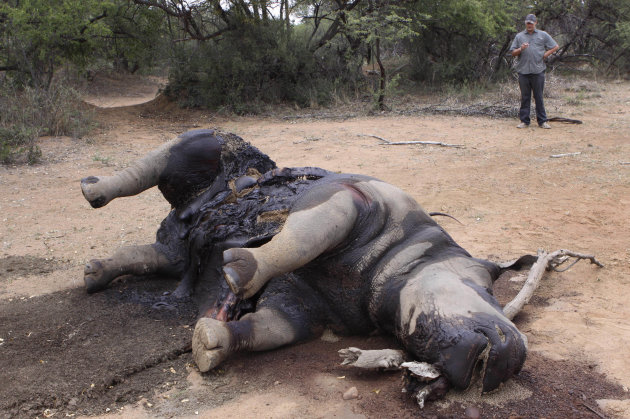South Africa: fight over rhino poaching escalates
By | Associated Press
JOHANNESBURG (AP) — A U.S. firm recently gave smart phones to some game rangers in South Africa to help them track poachers who kill rhinos for their horns. An anti-poaching ad campaign in Vietnam,
a key illegal market, shows rhinos with human hands or feet in place of
horns, which are made from the same material as fingernails and
toenails.
Despite these and other
globe-spanning projects to protect the rhinoceros, the rate of poaching
in South Africa — home to most of Africa's rhinos — this year is on
track to exceed the record number of illegal kills in 2012, conservation
officials say. The more money, innovation and publicity go into the
cause, the more poachers, who see rhino horn as a high-priced commodity, seemingly diversify their hunt.
It resembles a tit-for-tat escalation, similar to the old arcade game
"Whac-a-Mole," in which disparate campaigns can target a poaching
tactic or location only for the killing to pop up in other places and
forms.
"The demand seems to be such that every time there's a clampdown in one area, another issue emerges," said Dr. Jo Shaw, a rhino expert in South Africa for the World Wildlife Fund.
South Africa, a haven-turned-killing ground, was once a big success.
The intensity of the battle here has since made it a crucible for
experiments and policy debates on how to stop poachers seeking to meet
surging demand in some Asian countries. Consumers covet rhino horn after
it is ground into a powder as a balm for health, despite no supporting
evidence.
A South African opposition party
has urged the government to label rhino poaching as a national disaster,
allowing the allocation of disaster management funds to fight poaching.
The Democratic Alliance also called for more discussion about
legalizing the trade in rhino horns, which can grow back after cutting.
"A total ban on rhino horn trade will eventually lead to the complete
extinction of the species. A regulated and controlled trade would
supply demand and dismantle poaching syndicates through open market
pressures," opposition lawmaker Anthony Benadie said in a statement.Some conservationists warn that a legal trade would not necessarily stamp out the illegal one. Besides, it would require the approval of the Convention on the International Trade in Endangered Species, or CITES. The group, which has 173 signatory countries, met in Bangkok in March and won't meet again for three years.
Poachers killed 668 rhinos in South Africa in 2012, a 50 percent increase over the previous year. On April 18, South Africa said 232 rhino had been illegally killed so far this year, 70 percent of them in the vast Kruger National Park.
"The patterns keep indicating that it will be over 800" this year, said Shaw of the World Wildlife Fund.
She said the number of white and black rhinos in South Africa, 19,000
and 2,000 respectively, is actually rising. By some estimates, however,
the populations will reach a "tipping point" in 2016 and then decline
if poaching persists.Albi Modise, spokesman for South Africa's department of environmental affairs, said the use of gun silencers and other sophisticated equipment by poachers "requires that we up our game as well in terms of anti-poaching activity."
In one success, Shaw said, authorities have stopped Vietnamese and others killing rhinos in South Africa under the guise of legal trophy-hunting, and then illegally selling the horns abroad. South Africa regulates limited hunting of rhinos, though this practice is coming under increasing scrutiny.
The poaching crisis has triggered an array of measures whose effectiveness is hotly debated.
The private Sabi Sand game reserve has injected horns of some rhinos with a pink dye and chemicals that could sicken a person who ingests rhino horn. The tactic would be tough to implement in the nearby Kruger park, where rhinos are harder to track in the vast expanse and where rangers sometimes clash with armed poachers from neighboring Mozambique. CITES is pushing Mozambique to get tougher on poachers, and also urging Vietnam to take steps to curb demand.
Canvas, a Virginia-based technology company, equipped some rangers at the Sabi Sand reserve with smart phones this year. The devices enable them to swiftly share data and images — for example, footprints, holes cut in fences and animal carcasses — that help them patrol the bush and could eventually serve as courtroom evidence against suspected poachers.
James Quigley, head of Canvas, acknowledged there is a strong financial incentive behind poaching. The price of rhino horn has been compared to the U.S. street value of cocaine, a temptation for criminal syndicates, triggermen from poor villages and some corrupt officials.
"The risk versus reward becomes such that each side has to amplify just to keep in line with each other," Quigley said of the battle to stop poachers.
Tom Snitch, an American expert in imagery from satellites and drone aircraft, plans to test small drones in a South African game reserve in late May. He will use satellite imagery and mathematical models to plot flight paths based on predictions of the movements of both rhinos and poachers.
"If we see the poachers, we put the drones on top of them and basically vector them in where they can be apprehended," Snitch said. Some of the technology mirrors that used by U.S. forces to detect insurgents planting roadside bombs in Iraq and Afghanistan, and the fight against poachers is similarly cat-and-mouse, he said.
"You constantly have to refine your model in the anticipation that your adversary is learning your techniques and tactics," said Snitch, a visiting professor in computer studies at the University of Maryland.
South Africa has signed an anti-poaching deal with Vietnam, which has pledged more rigorous inspections of cargo, particularly from Africa, at land, air and sea entry points as well as public awareness campaigns. The World Wildlife Fund
and TRAFFIC, a wildlife monitoring network, are launching an ad
campaign on social media networks and elsewhere in Vietnam. One poster
depicts hands and feet on a rhino's face, noting human nails and rhino
horns are both made from a tough protein called keratin.
The caption reads: "Rhino horn is made of the same stuff as human nails. Still want some?"


ไม่มีความคิดเห็น:
แสดงความคิดเห็น